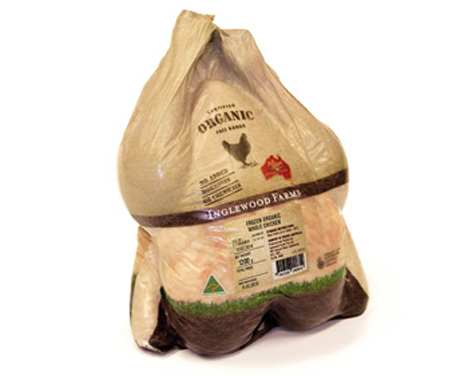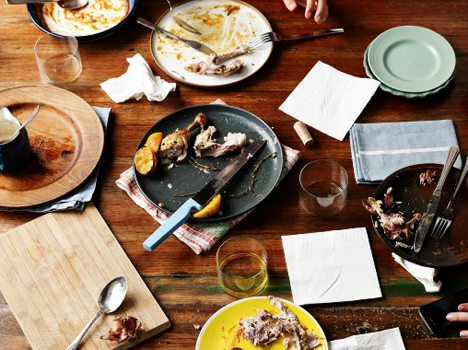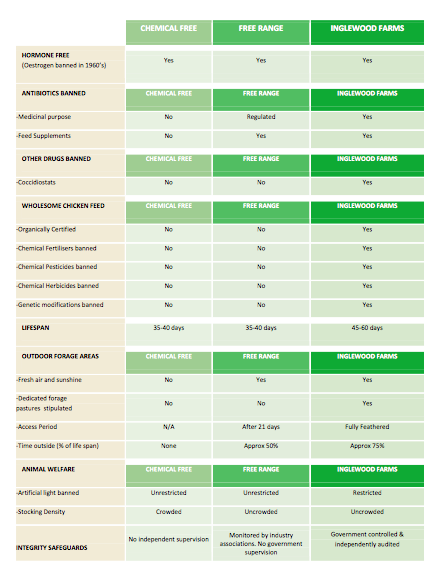The past few weeks I’ve been digging around for the cleverest, tastiest most sustainable, healthiest and most economical way to eat chicken. You know, I get obsessed…
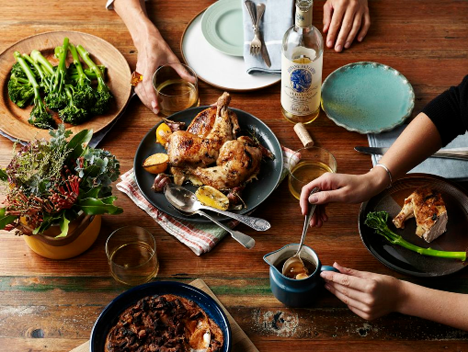
I’m personally fatigued by the competing messages when it comes to weighing up the ethical v eco v health v hip pocket considerations and wanted to find a snaptight solution to buying and eating a damn chook that ticks off everything. You too?
After a little consultation and some Googling and kitchen playing I found The Solution. It lies in this technique, which can be summed up in a menu grab:
Organic crispy skin roast chook. With a side of broth.
There’s a full circle story to eating chicken. And it’s really worth knowing it from beginning to end (and back again). I’ll break it down into points…
And just so you know, this is a sponsored post, but opinions are all my own and I researched the topic and came to these conclusions myself. You’ll find my position on sponsored posts and advertising here.
1. The most ethical, environmental and economical way to eat chicken is to eat different joints.
I’ve written about why it’s important to eat the whole animal before. Meat should be eaten respectfully. Eating all of an animal – not just the fashionable cuts, such as the breast – is the most mindful and conscionable way to go about things. It also saves a lot of cash as some of the unfashionable cuts are cheaper (wings anyone?). I really suggest playing around with drumsticks recipes (for bonus health reasons as I outline below), or recipes that use all different cuts of the chook… to see what you like best. I’ve provided details below of how to roast cuts of chook, too (if you’re not into buying a whole bird). I also like this recipe, which plays about with different cuts. Buy up several at your supermarket and experiment.
2. Eating all your chook is best for your health.
Let’s break it down into some watercooler points:
- The skin is highly nutritious: it contains fat-soluble vitamins and fatty acids.
- Dark meat is better for you than the white: it contains more minerals.
- The cartilage-y bits (the joints and wings) and the bones are the healing bits: these parts are where the minerals – particularly calcium, magnesium and potassium – are contained that feed, repair and calm the mucous lining in the small intestines and calm the nervous system. The gelatin in these parts also aid protein metabolism. Below I’m going to show you how to get the most of this phenomenon by cooking up the joints and wings and bones into a broth.
3. But to do this you must eat healthy organic chickens…
Quite simply free-range chooks don’t cut it, to my mind. Remember, free range certification merely means the bird is able to move outside a cage. This ticks off one (ethical) consideration. Free-range chooks can still be fed nasty chemical-laden feed, and can be fed supplements to speed up their growth process which means their skeletons don’t grow properly, and this causes a host of issues. Organic chooks are free range AND supplement/chemical/antibiotic free. (For more on the difference between free range and organic, see below).
To my mind, organic is the ONLY way to eat chicken. For this is the thing: if you’re going to eat the whole bird, especially if you’re going to cook up the bones and cartilage and extract the minerals (which you’re going to want to, right?!), you really don’t want to be extracting a whole heap of supplements and chemicals from it as well (right?!).
4. …And to do this, you need to get economical.
By now it might all be looking complicated. And expensive. I know a big stumbling block to eating organic chickens is the extra cost. But if you’re buying organic, you can eat more of your chook with peace of mind. Which is economical. Which brings us full circle.
And, just to put things in perspective, a whole organic Inglewood Farms chook (which I use) costs about $20 and feeds 5-6 people. That’s $4 or so a serve. Inglewood Farm’s drums and wing portions are $9 per kg, while their popular chicken breast is $29.90 per kilo, which is a lot less than most standard (non-organic) meats and fish you’ll find at the supermarket.
Also, you if you buy an air-chilled chook, you’ll get even more bang for your buck. Most chickens in this country (both conventional and otherwise), are water-chilled (more details below) which adds 17 per cent more weight – in chlorinated water! Inglewood Farms chooks are air-chilled, not water-chilled.
5. And to tick off all the boxes, it’s best to cook Roast Chook with a Side of Broth
The beauty of cooking a whole roast chicken is that you can pull off the not-so-good-when-roasted-bits (the wingettes, neck etc) before cooking AND use the carcass after you’ve roasted and eaten all the meat off it to then make a chicken stock (I’ve posted on the health benefits of chicken stock, and recipes). You can use the stock to baste and to make your chicken sauce on your next roast…and so it goes around and around.
Bonus: The chicken stock is chock-full of minerals which calm the gut and help digest the entire meal. Again, around and around.
Before I share the recipe, however, I figured you might like to know a few extra bits and pieces about eating chicken:
- Look for white skin: the yellow skin pigmentation you find on conventional chickens is derived from xanthophyll, which naturally occurs in yellow corn, indicating the chook’s been fed on corn and grain.
- Avoid roasting a frozen chook. They can be too watery. If you do use a frozen one, however, always thaw it in the fridge, uncovered, on some paper toweling and pat it dry before cooking.
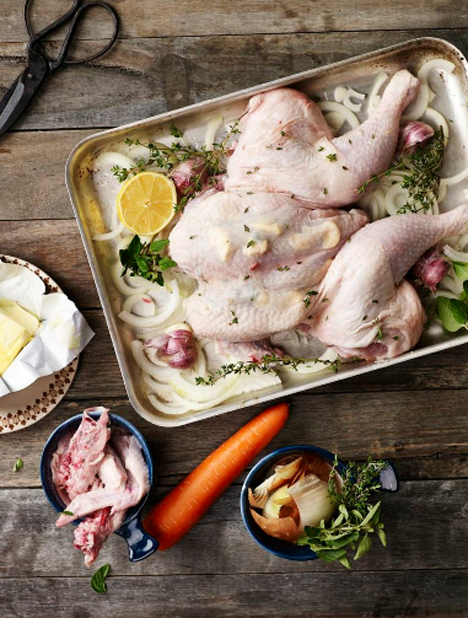
Cheats Crispy Roast Chicken with Sweet Potato Casserole
This recipe combines the best of a number of techniques for roasting a cook, starting with cutting the whole chook in half, thus shortening the cooking time and not requiring constant turning, and, to my mind, making for a moister roast. Plonking things directly on top of the onion adds so much flavour, and stuffing butter under the skin ensures extra crispy skin.
- 1 Inglewood Farm chicken, room temperature
- 1 onion, thinly sliced (keeping the end cuts)
- 1 whole head garlic, chopped in quarters
- 1 tablespoon butter
- sprigs thyme or oregano
- sea salt and pepper
- 2 lemons, halved
- ½ cup chicken stock, vermouth or dry white wine
Preheat the oven to 200 C. Toss onion and garlic (cut side down) in a roasting pan. Grab a sharp pair of kitchen scissors and cut the chicken in half down either side of the backbone (the chunkier, bonier “spine”, not the smoother breast bone) and snap/cut the wings at the end joint and remove. Also cut off any chunky bits of fat.
Plonk the spine, wingettes and excess fat in a big stockpot with the onion end cuts and set aside.
Pat down the chicken, inside and out, with paper toweling to ensure it’s dry.
Now, this is the fun bit: using your fingers and working from the chicken’s bum end, pull the skin from the breast and slide your fingers all the way up. Poke half the butter and some of the herbs up under the skin.
Rub the chicken on both sides with lemon juice, and rub down with salt and pepper and herbs. Splay the chook over the onion, placing the squeezed lemon halves underneath and sprinkle little chunks of the remaining butter over the top. Cook in the oven for 45 minutes.
At 15 and 30 minutes, baste with the juices from the pan. The chook will be ready when you poke a drumstick with a skewer and the juices run clear, not pink.
Remove the chook to a serving dish, along with the garlic and lemon, cover and leave in the still-warm oven. Place the pan over heat and deglaze with the stock/wine/vermouth and bring to a boil, scraping the onions and fatty bits. Add a little more liquid if you like and reduce. You can strain the sauce (I prefer not to), and serve with the chicken, sweet potato casserole and some steamed greens.
When dinner’s done, collect all the bones – it doesn’t matter if people have chewed them; they’re about to be boiled – and add to the stockpot. Throw in any other odd bits of veggies – carrot, celery, celery leaves, parsley; old and floppy is fine. Toos in a few bay leaves, too. Cover with water and a splash of vinegar, bring to the boil, then simmer, covered, for several hours. When done, strain into a container, chuck out the bones and veggies, and place the stock in the fridge. After a few hours skim the fat/scum at the top and then store the stock in the freezer in one-cup batches or in ice cube trays. You can then use it to make my My Anti-Anxiety Soup.
If you don’t have time to make stock that day, just put the whole lot in a bag in the freezer, adding veggies, meat and herbs to the bag, until you’re ready to boil it up.
Sweet Potato Casserole
- coconut oil, butter or ghee for greasing
- 3 cups sweet potato puree
- 3 tablespoons almond milk
- 1 tablespoon rice malt syrup
- 1 teaspoon vanilla powder
- pinch of salt
- 1/2 cup pecans, chopped (preferably activated)
- 1 teaspoon ground cinnamon
- 1/2 teaspoon ground ginger
- 1/2 teaspoon ground allspice
Preheat the oven to 180 C and lightly grease a small baking dish. Combine the sweet potato, almond milk, syrup, vanilla powder and salt and pour into the baking dish. Toss the remaining ingredients in a small bowl, then sprinkle evenly on top of the sweet potato mixture. Bake for 30 minutes. Serve immediately, with cream if having for dessert.
Why organic and not just free-range?
There are all kinds of reasons why organic is the only way to go. Three that strike me as core are:
- The standards are higher…across the board: Certified Organic producers are audited on a regular basis and have to go extra miles to maintain their accreditation. This has led Inglewood Farms Organic to hatch their own chooks, feed them using most of their own organic grain (less carbon miles!), and give their birds access to 45 percent more outdoor space than accredited free-range birds.
- Organic chooks grow slower…meaning better meat… and ethics: Conventional (and some free range) chickens are intensively raised to be ready for consumption in as little as 32 days, while organic chooks are slower to reach maturity with a recommended age of 60 days, which adds to the heftier (but worth it) price tag.
- The chemicals and supplements factor: Clinical nutritionist and health coach Sally Joseph says that certified organic poultry is the only poultry product that is 100 per cent guaranteed to be antibiotic-free. There’s also compelling new evidence of a direct link between pervasive, difficult-to-cure human diseases, such as E.coli, and supplement/chemical-fed chicken. You can read more on that here. “We’re finding the same or related E. coli in human infections and in retail meat sources, specifically chicken,” says Amy Manges, epidemiologist at McGill University in Montreal. “We’re particularly interested in chickens. They, in many cases, are getting drugs from the time that they were in an egg all the way to the time they are slaughtered.”
For more factoids, here’s a handy breakdown of the free range vs organic facts:
Why an Inglewood Farms Chook?
- It’s Certified Organic, Accredited Free Range and hormone, chemical, growth promotant and antibiotic-free. All birds are fed organic feed exclusively from the farm.
- There are a bunch of organic brands out there, but they can be hard to find. Inglewood Farm is the biggest supplier in the land and so they can be found in Woolworths, Coles, IGA, Franklins, Harris Farm, Thomas Dux.
- Most significantly – and unlike most organic and conventional chickens – it’s air chilled, not spin chilled. The latter involves dropping the birds in to an iced slurry of chlorinated water. Chooks absorb this “bleached” water, gaining up to 9 percent weight. So, not only are you getting bleached chook, you’re paying for the extra weight. Inglewood Farm chooks, in fact, lose 2 per cent weight from the air chill process, thus intensifying the flavour (and value). Air chilling also enhances shelf life.
- All of which makes for a much sweeter “like Grandma used to make it” chicken. I’ve cooked the above recipe a few times and noticed both the fact this one was not “soggy” at all (so it crisped super easy) and was very “chicken-y” in flavour.
- A whole chook, which will feed six, costs about $20. Which is more than a conventional chicken, sure. But when you engage in the full circle of chook cooking, I assure you, you come out way on top.
How do you take your chicken further? Do you have any questions about where to find an Inglewood Farm chook or how to cook it?
Posts on sarahwilson.com may contain links to sponsors and affiliates with the capacity to receive monetary compensation, which helps to support the growth and development of this site. Giveaways are sponsored promotions and will always be stated as such on the post. Books, eBooks and other products that align with my site and ethos may potentially be accepted for review, but please respect my desire not to clutter my life with “stuff” before you send your wonderful product or press release. I am not a medical professional; rather, a wellness advocate, therefore anything written by myself on this site is my own (researched) opinion and not advice from a trained doctor. Here is a full breakdown of my position on sponsored posts and advertising.
